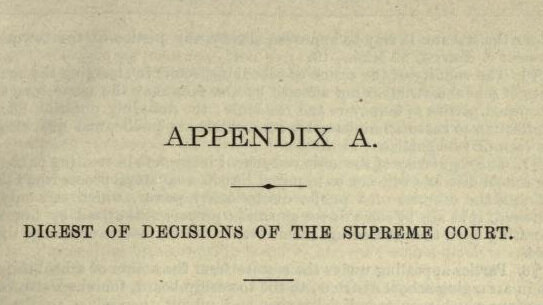Create a Great Book Appendix: A Guide for Nonfiction Authors
The appendix to a book is like the fake grass in an Easter basket. In the Easter basket “grass,” there were always little nuggets hiding—little chocolate eggs, jelly beans, and who knows what else—for those who sifted through it. And I swear that Easter basket “grass” was just green-colored cassette tape film. Amiright? Only a child or a parent of the ’80s could relate. . . .
Clients often ask me what to put in the appendix of a book. Maybe you’re wondering: "What goes in an appendix, and how do I structure it?" Below are some frequently asked questions and answers about the subject.
After reading this post and the Q&As, you’ll be ready to create a great supplement to your book.
What is an appendix in a book?
An appendix (plural: appendixes) is supplementary material at the end of a piece of writing that brings value and insight to the reader. It is typically placed at the back of a book. According to The Copyeditor’s Handbook (p. 301), “An appendix gives the reader additional context that would seem distracting in the body of the book.”
An appendix, The Copyeditor’s Handbook adds, “offers a deeper understanding of a topic covered in the text; it does not simply contain table scraps left over from the author’s research after the manuscript is written.” An appendix consists of material that is neither required nor essential. Rather, it is relevant bonus information unsuited for placement in the main text.
Where is the appendix located in a book?
An appendix goes in the back matter, followed by these parts of the book (if included): chronology (if not in the front matter), glossary, notes/references, bibliography, index, and biographical note.
An appendix might appear online, whether or not it appears in a book. In rare cases, e.g., in an edited volume, it might go at the end of a chapter.
If length and cost are concerns, consider posting supplementary material to your author website, whether or not it appears in your book. You’ll not only save pages and money, you’ll also drive traffic to your site. And you can add more related content in the future.
Can I have more than one appendix?
You may include one appendix or several appendixes. Don’t get carried away, though!
If you have more than one appendix, each appendix begins on a new page, with the titling system Appendix A, Appendix B, etc.
Appendixes should appear in the order referenced in the main text.
Wait, is it appendixes or appendices?
The Chicago Manual of Style (CMOS) uses “appendixes” (without quotes).
The ultimate arbiter of general spelling matters for the CMOS is Merriam-Webster’s Collegiate Dictionary. CMOS prefers to use the primary variant for a given word. (See CMOS, p. 418, section 7.1 and p. 419, section 7.6.)
The Collegiate (p. 60) gives “appendixes” as its primary variant, so use this spelling.
Appendix is a sixteenth-century word of Latin origin. As Patricia T. O’Conner and Stewart Kellerman have observed, “Over time, plural endings of foreign-derived words tend to become Anglicized.”
Some dictionaries, e.g., Collins, which covers British English, prefer “appendices.” Traditional publishers and self-published authors may wish to exercise their own preferences. In any case, be consistent.
What should I include in an appendix?
My clients include lists, further resources, legislative and executive proclamations, transcriptions of primary source documents, genealogical information, speeches, or transcribed audio clips.
Theses and dissertations put interview questions, surveys, or IRB approval letters in appendixes.
In a biography of Sacagawea, the authors used appendix D to present a list of memorials to Sacagawea: geographical features, statues, and markers, among other things, named after the famous Indian guide.
Finishing your book? Time to polish it and get it ready for publishing.
How do I format a book appendix?
There is no single format for an appendix.
Appendix headings look like chapter title headings. An appendix can have subheadings, if substantive. Each new appendix begins on a new page. If you have related items, you can group them into one appendix.
In the table of contents and in the heading of each separate index, the titling system is as follows: Appendix (if you have only one), or Appendix A, Appendix B, etc.
According to CMOS, 17th edition (p. 30–31, section 1.59), it is permissible to number appendixes 1, 2, 3, etc., rather than A, B, C, and it is permissible to set them in a smaller type than the main text. If you have numbered tables within an appendix, the numbering scheme can cause confusion. My personal advice: stick to A, B, C.
What are some rules for capitalization and punctuation?
A note about capitalization from CMOS: When an author refers to a chapter or an appendix in the text, “Chicago prefers to lowercase the parts of a book, even if they’re titled generically, so in running text we would refer to “‘appendix A.’”
Have you seen periods (full stops) after the word “Appendix” in an old book? Periods after chapter titles? Don’t do it. It is no longer considered standard practice. Period.
Is an appendix indexed?
From The Chicago Manual of Style, 17th edition:
“Book appendixes should be indexed if they contain information that supplements the text, but not if they merely reproduce documents that are discussed in the text (the full text of a treaty, for example, or a questionnaire). Appendixes to journal articles are indexed as part of the articles. Glossaries, bibliographies, and other such lists are usually not indexed.”
What else do I need to know?
Not all books need an appendix or appendixes.
Too many authors overload an appendix with irrelevant information. Ask yourself: Is it valuable for my readers? Is it relevant?
As a reader I often find appendixes to be a useful bonus, and in my developmental editing and copy editing work, I enjoy working with authors on what to leave in and what to leave out.

